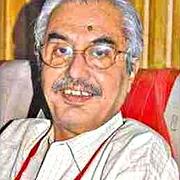F. N. Monjo (1924–1978)
Auteur de The Drinking Gourd: A Story of the Underground Railroad
A propos de l'auteur
Crédit image: Ferdinand Nicolas Monjo (1924-1978)
Séries
Œuvres de F. N. Monjo
Grand Papa and Ellen Aroon: Being an Account of Some of the Happy Times Spent Together by Thomas Jefferson and His… (1974) 52 exemplaires
Letters to Horseface: Being the Story of Wolfgang Amadeus Mozart's Journey to Italy 1769-1770 when He Was a Boy of… (1975) 32 exemplaires
Willie Jasper's Golden Eagle: Being an Eyewitness Account of the Great Steamboat Race Between the Natchez and the… (1976) 14 exemplaires
A Namesake for Nathan: Being an Account of Captain Nathan Hale by His Twelve-Year-Old Sister, Joanna (1977) 12 exemplaires
Slater's Mill 1 exemplaire
Bird Watch 1 exemplaire
Oeuvres associées
Clarence and the Burglar: Adapted from a chapter in Clarence the TV Dog (1973) — Adapter — 38 exemplaires
The Lively Adventures of a Burly Woodcutter, a Pint-Sized Inventor, Two Pretty Pastry Cooks, and a Gang of Desperate… (1966) — Traducteur, quelques éditions — 7 exemplaires
Cricket Magazine, Vol. 2, No. 12, August 1975 — Contributeur — 2 exemplaires
Cricket Magazine, Vol. 2, No. 11, July 1975 — Contributeur — 2 exemplaires
Cricket Magazine, Vol. 3, No. 6, February 1976 — Contributeur — 2 exemplaires
Étiqueté
Partage des connaissances
- Autres noms
- Monjo, Ferdinand Nicholas III
- Date de naissance
- 1924-08-28
- Date de décès
- 1978-10-09
- Sexe
- male
- Nationalité
- USA
- Lieu de naissance
- Stamford, Connecticut, USA
- Lieux de résidence
- New York, New York, USA
- Études
- Columbia University (1946)
- Professions
- editor
assistant director
vice-president
editorial director in Books for Boys and Girls - Relations
- Monjo, Justin (son)
- Courte biographie
- F. N. Monjo’s grandson, Ferdinand Nicholas Monjo III (1924–1978), became a popular children’s author, and wrote about his grandfather’s business in several of his books.
Ferdinand Nicolas Monjo was born August 28, 1924 in Stamford, Connecticut. He graduated from Columbia University in 1946 and worked as an editor and later assistant director and vice-president and editorial director in Books for Boys and Girls at several major publishing companies. In 1968, he published his first book for children, Indian Summer, the story of a frontier woman's struggle to save her family.
During the 1970s, Mr. Monjo published many other works of historical fiction, most written from "a child's point of view in an effort to humanize our forefathers." Critics praised his writing style for making "the child's voice authentically his own" and also lauded his attention to detail and "historical fact." Critics also praised his writing style for giving children "a fresh and appealing look at any number of otherwise overworked periods of history" and called him one of the best "in the writing of easy-reading history books." F. N. Monjo received several honors for his works: Poor Richard in France (1973) won the National Book Award in 1974 and The Drinking Gourd (1970) was an ALA (American Library Association) Notable Book. Today, it is perhaps his most remembered book.
He and his wife raised their four children in New York City. His youngest son, Justin Monjo, found an unfinished manuscript of his father's, which he subsequently finished: 3 Kinds of Scared was published by Allen & Unwin in September, 2003. F. N. Monjo died on October 9, 1978.
Membres
Critiques
Listes
Prix et récompenses
Vous aimerez peut-être aussi
Auteurs associés
Statistiques
- Œuvres
- 30
- Aussi par
- 7
- Membres
- 2,708
- Popularité
- #9,488
- Évaluation
- 3.8
- Critiques
- 19
- ISBN
- 69
- Langues
- 1
- Favoris
- 1




















